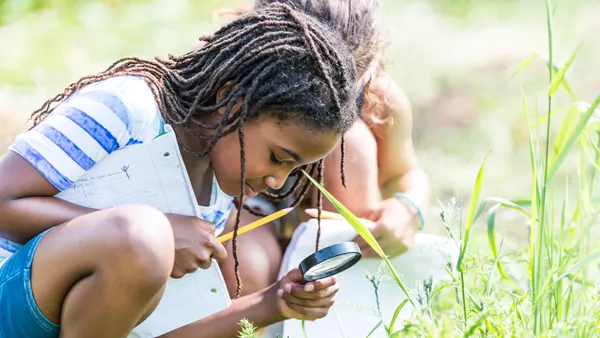Dive Brief:
- When English teacher Amy Schwartzbach-Kang was asked to co-teach a trigonometry class in the Chicago Public Schools due to a shortage of special education teachers, for which she was certified, she moved beyond her initial aversion to math by developing supplementary lessons to add a sense of personal meaning and creativity to the subject, she writes for Edutopia.
- The lessons in question shifted the focus from having students simply find the right answer to one of finding a way to detail how they got to an answer as though they were detailing it to a child.
- Students were asked to show how they got their answers by writing simple and concise stories, in addition to also looking at story problems in their books and approaching them as an actor would a script, building a backstory for characters and tying multiple problems together to create their own math story — one they wrote and wanted to solve.
Dive Insight:
Thinking of math as a creative subject doesn’t mean reinventing what 2 plus 2 equals, but instead looking at innovative ways to engage students in math. One way to spice up the subject is by bringing storytelling into lessons.
Storytelling can help turn math into something fun while kickstarting a student's interest in numbers. Storytelling in particular, spoken aloud rather than being read from a page or in a book, can help embed lessons more deeply. From making “constant eye contact” — as opposed to “reading from a book,” where someone’s head is down — this different style of engagement can help students connect more to a storyteller and to the lesson at hand, as detailed by educators Mary Barr Goral and Cindy Meyers Gnadinger in a 2006 piece titled “Using storytelling to teach mathematics concepts."
Storytelling may also boost social-emotional learning capabilities in children, particularly those around creative and critical thinking, given the connection between the arts and SEL skills.
In a 2018 paper, “Promoting Creativity and Critical Thinking Though Digital Storytelling: Perceptions of Undergraduate Students,” Ohio Northern University education faculty member and researcher Albert Akyeampong noted that college students stated they needed to use critical thinking skills to consider how to tell a story using the tools at hand — in their case, digital technology. With K-12 students, critical and creative thinking skills would also be tapped in considering how to follow or even create a narrative around math problems.










